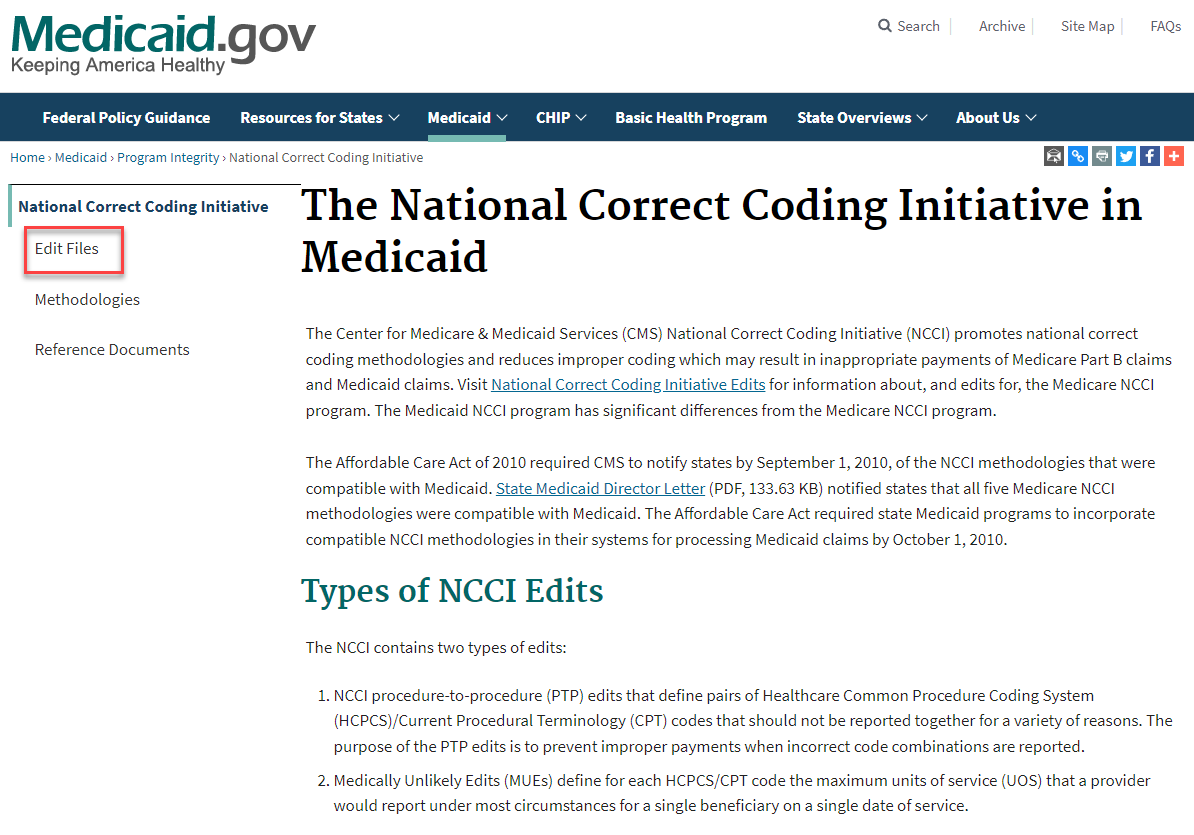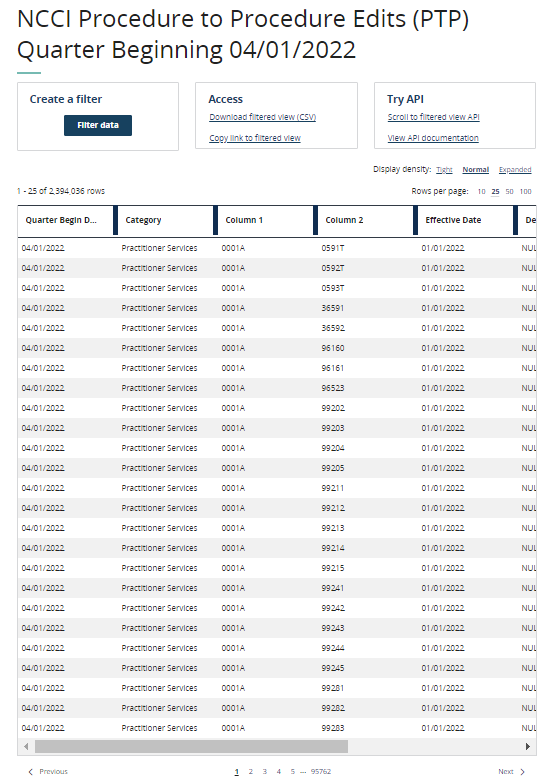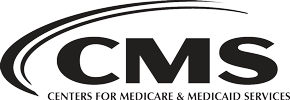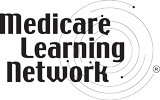Using the Medicaid NCCI Tools
To look up an edit, first choose the Edit Files link in the menu on the left side of The National Correct Coding Initiative in Medicaid webpage as shown in Figure 1.

Figure 1: NCCI in Medicaid Webpage
You’ll see the Medicaid NCCI Edit Files webpage as shown in Figure 2.

Figure 2: Medicaid NCCI Edit Files Webpage
This webpage includes links to Medicaid NCCI edits for DME Services, Outpatient Hospital Services, and Practitioner Services for the current and previous quarters. Choose a link to review the most recent quarter of the NCCI PTP edits or MUEs.
Helpful Hint
Remember that PTP and MUE tables are updated quarterly, and you must completely replace saved tables to make sure you use the most current files.
Let’s start with a review of the Medicaid PTP edit files.
Looking up PTP Code Pair Edits
Go to the Medicaid NCCI Edit Files webpage. Choose the NCCI PTP Edits link, for the services you want, under the Complete Medicaid NCCI Edit Files heading. We are using the NCCI Procedure to Procedure (PTP) Edits Quarter Beginning 04/01/2022 dataset for Practitioner Services as the example for this educational tool but remember that you will select a link and data with the most recent date. Figure 3 shows the top of the NCCI Procedure to Procedure (PTP) Edits webpage for Practitioner Services for the quarter beginning 04/01/2022.

Figure 3: Medicaid NCCI PTP Datasets Webpage
The dataset webpage offers information about the edit files, including the number of rows and columns.
You’ll find links to PTP edit files for the previous quarter at the bottom of the Medicaid NCCI Edit Files webpage.
How to Use PTP Code Pair Edits
The Column One and Column Two columns in the edit files show PTP code pairs. We’ll show how to use the PTP code pair tables with example code 99215. Our examples using the Medicaid NCCI PTP Edits tables and code 99215 will show:
How to Use the Column One and Column Two Tables
- When is a code the reimbursable code of a PTP code pair?
- How do you figure out if Medicaid doesn’t reimburse a code or only reimburses a code if you use an appropriate NCCI PTP-associated modifier?
- When can you use an appropriate NCCI PTP-associated modifier?
What are the Column One and Column Two PTP code pair tables?
The Column Two code often is part of a more comprehensive Column One code. But this isn’t true for many edits. In some types of edits, the PTP code pair edit simply means 2 codes that providers shouldn’t report together, unless you use the correct modifier.
Don’t report certain procedure codes together when they’re mutually exclusive of each other. Mutually exclusive procedures cannot reasonably be performed at the same anatomic site or same patient encounter.
Examples of mutually exclusive procedures:
- When there are different codes for different methods to repair an organ, a provider can only report 1 method to repair the organ.
- A provider can’t report an initial “per day” service and a “subsequent” “per day” service for the same date of service. For example, a provider shouldn’t report Skilled Nursing Facility Evaluation and Management service 99304 (Initial nursing facility care, per day) and 99307 (Subsequent nursing facility care, per day) together on the same day for the same patient by the same practitioner.
When is a code the reimbursable code of a PTP code pair?
The Medicaid NCCI PTP code tables include Column One and Column Two code pairs. If a provider reports the 2 codes of an edit pair on a claim for payment for the same patient on the same date of service, the Column One code is eligible for payment and the Column Two code is denied. But if both codes are clinically appropriate and the edit allows the use of an appropriate NCCI PTP-associated modifier, Medicaid will pay for the codes in both columns. The patient’s medical record must include supporting documentation.
You can find out when example code 99215 is the reimbursable code of a PTP code pair by opening an edit file link and using the Filter data button to search for 99215 in the Column One column. (More information about the filter tool is in the Filtering the NCCI Data Tables section.)
Figure 4 shows part of the our example NCCI Procedure to Procedure (PTP) Edits Quarter Beginning 04/01/2022 edit files for Practitioner Services, with example code 99215 in the Column One column.

Figure 4: Portion of Medicaid NCCI PTP Dataset
- Quarter Begin Date: The first date that this quarterly edit file is effective
- Category: The category of service
- Column One: Shows the payable code
- Column Two: Shows the code that isn’t payable with this particular Column One code, unless an appropriate modifier is allowed and used
- Effective Date: Shows the effective date of the PTP edit (month, day, year)
- Deletion Date: Deletion date of the PTP edit
- Modifier Indicator: Shows if a modifier is allowed to override the PTP edit (Modifier indicators are defined later in this section.)
- PTP Edit Rationale: Shows the rationale for each PTP edit
Our search shows a portion of all Column One and Column Two PTP code pairs where 99215 is the payable code and every code that isn’t separately payable when you report it with 99215 (unless a modifier is allowed) based on the Column One or Column Two edits.
Figure 4 shows, for example, that a provider isn’t reimbursed for code 0362T (Behavior identification supporting assessment for patient exhibiting destructive behavior, each 15 minutes of technicians’ face-to-face time) together with 99215 (Office or other outpatient visit) unless you append a modifier.
How do you figure out if Medicaid doesn’t reimburse a code or only reimburses a code if you use an appropriate NCCI PTP-associated modifier?
In other words, you also may need to know when a code appears as a Column Two code.
To decide when our example code 99215 is the non-reimbursable code of a PTP code pair, we open an edit files link and use the Filter data button to search for 99215 in the Column Two column.
If you filter for 99215 in Column Two, you’ll see that Medicaid doesn’t reimburse 99215 with 99221, Initial hospital care, unless you use the correct modifier.
How do you know when to use an appropriate NCCI PTP-associated modifier?
Providers can append modifiers to HCPCS/CPT codes only if the clinical circumstances and documentation justify it. Providers can’t append a modifier to a HCPCS/CPT code solely to bypass a PTP code pair edit if the clinical circumstances don’t justify its use. If a state Medicaid program imposes restrictions on a modifier, a provider can only use the modifier to bypass an NCCI PTP code pair edit if the Medicaid program allows it.
In the modifier indicator column in the Medicaid PTP tables, the indicator 0, 1, or 9 shows whether a PTP-associated modifier allows the PTP code pair to bypass the edit.
Correct Coding Modifier Indicators
- 0 (Not Allowed): A modifier indicator of “0” indicates that NCCI PTP-associated modifiers cannot be used to bypass the edit.
- 1 (Allowed): A modifier indicator of “1” indicates that NCCI PTP-associated modifiers may be used to bypass an edit under appropriate circumstances.
- 9 (Not Applicable): A modifier indicator of “9” indicates that the edit has been deleted.
Now that you’ve learned how to use the PTP code pair tables, let’s learn how to search for MUEs.
Looking up Medically Unlikely Edits (MUEs)
An MUE for a HCPCS/CPT code is the maximum UOS that a provider would report under most circumstances for a single patient on a single date of service.
Not all HCPCS/CPT codes have an MUE.
CMS develops MUEs based on:
- HCPCS/CPT code descriptors
- Coding instructions
- Anatomic considerations
- Established CMS policies
- Nature of service or procedure
- Nature of analyte
- Nature of equipment
- Prescribing information
- Clinical judgment
MUE values aren’t utilization or coverage guidelines and don’t represent UOS that providers may report without concern about medical review. Providers can only report services that are medically reasonable and necessary. A denial of services due to an MUE is a coding denial, not a coverage or medical necessity denial.
Return to the Medicaid NCCI Edit Files webpage and choose an NCCI MUE link under the Complete Medicaid NCCI Edit Files heading.
Figure 5 shows the unfiltered MUE table on the NCCI Medically Unlikely Edits (MUEs) dataset webpage for Practitioner Services as of the date of writing of this publication.

Figure 5: Portion of Medicaid NCCI MUE Dataset
- Quarter Begin Date: The first date the quarterly edit file is effective
- Category: The category of service
- HCPCS/CPT Code
- MUE Value: MUEs define for each HCPCS/CPT code the maximum units of service that a provider would report under most circumstances for a single patient on a single date of service
- MUE Rationale: Shows the rationale for each MUE value


